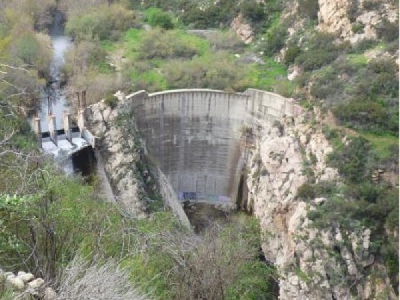
Posted on February 23, 2017
By Suzanne Guldimann, Malibu Surfside News
Rindge Dam in Malibu Canyon, built to provide a reliable source of water for the Rindge Family’s ranch and the growing community of Malibu, was completed in 1926. It took two years to construct and cost $152,928.
A California Department of Parks and Recreation’s plans to remove the defunct structure is expected to take eight years and is estimated to cost between $118 million-$211 million, with the preferred option carrying a $187 million price tag, according to a new report released by State Parks and the Army Corps of Engineers.
The U.S. Army Corps of Engineers will hold a public hearing on the dam removal project from 6-8 p.m. Wednesday, March 1, at the Las Virgenes Municipal Water District, located at 4234 Las Virgenes Road in Calabasas.
The Draft Integrated Feasibility Report is a massive document, at almost 600 pages long. It outlines and assesses numerous options for the removal of the dam and the sediment impounded behind it. The report also identifies a host of potentially significant environmental impacts that include traffic, water quality, air quality, biological resources, cultural resources, aesthetics and noise.
State Parks has sought the removal of the dam, located within Malibu Creek State Park, for nearly 20 years. Although the dam remained in use through the early 1960s, records show it never operated at full capacity. The reservoir began filling with sediment almost as soon as it was completed. The spillway gates were damaged during heavy rains in 1945, further reducing the 574-acre-foot reservoir capacity to just 75-acre-feet. (An acre-foot is defined as a unit of volume equal to the volume of a sheet of water one acre in area and one foot in depth.)
The facility was decommissioned in 1966.
Park ecologists argue that the dam prevents the critically endangered Southern California steelhead trout from reaching the upper Malibu Creek Watershed.
Wild steelhead trout spend most of their lives in the ocean, returning only to the freshwater creeks were they hatched to spawn and die. Critics of the dam removal project, including members of the Rindge family, question whether wild native steelhead trout were ever present in the upper watershed. A natural obstacle, Tunnel Falls, is located less than a mile upstream from the Rindge Dam, with two additional manmade barriers, the Century and Malibou Lake dams, just above that.
The Draft IFR concedes that evidence for the fish in the upper watershed is largely anecdotal. However, it makes the case that the dam and other upstream road crossings and smaller dams aren’t only obstacles to the endangered fish, but that they block “historic migratory paths for mammals, isolating reaches of Malibu Creek and tributaries in the watershed.”
The document also finds that the dam reduces the amount of natural sediment delivered to the beach during storms, and that it has changed the natural creek slope, resulting in “undesirable impacts on flow velocities, vegetation types, water temperatures and aquatic habitat.”
The study reveals that the dam is no longer accumulating sediment. “Although [researchers] initially assumed that Rindge Dam was still accumulating sediment, further investigations and modeling confirmed that the dam has reached its storage capacity with the current volume of impounded sediment,” the report states.
“During peak events, the entire flow in Malibu Creek overtops the dam’s crest transporting sediment eroded from the watershed to downstream reaches of Malibu Creek and the ocean,” the report finds.
The Draft IFR allays concerns that the structure is currently unsafe.
“Although Rindge Dam is now 90 years old, the dam arch and spillway are assumed to remain intact in the future,” the document states.
The findings indicate that while “there is a likelihood of continued deterioration due to its age,” the risk of age alone leading to catastrophic failure of the arch structure is low.
“The dam arch is no longer subject to dynamic water loading with no reservoir pool behind it for many decades,” the report states. “The impounded sediment places a static load on the arch. Seismic activity could result in a catastrophic failure of the dam arch and although the downstream detrimental consequences of such an event could be significant, the risk of that occurring is relatively low.”
The Draft IFR concludes that the main safety hazard comes from “young adults accessing the spillway, and their continued disturbance to critical habitat for steelhead is likely at the large pool at the base of the dam,” rather than structural failure.
The report explores many dam removal options, including a 50-year plan to leave the spillway and cut the dam down incrementally to allow the sediment to clear naturally.
However, the preferred plan calls for removing the spillway, the 100-foot-high concrete dam, and the 780,000 cubic yards of sediment impounded behind it. The concrete would go to the Calabasas landfill. The sand would be trucked to Ventura, loaded onto barges and returned to Malibu beaches by sea.
The report acknowledges that the Rindge Dam is potentially historic, and proposes commemorating its place in local history after its removal by placing interpretive signage at the overlook above the site. Residents say interruptive signs may also be required. They worry that truck trips required to remove more than a million tons of sediment and debris will negatively impact their lives and complicate commuting for years.
The Draft Integrated Feasibility Report can be viewed at www.malibucity.org/CivicAlerts.aspx?AID=424.
To weigh in on the project
Public comment on the Rindge Dam project will be accepted through March 27 and should be directed to:
Eduardo T. Demesa
Chief, Planning Division
US Army Corps of Engineers, Los Angeles District
Attn: Mr. Jesse Ray (CESPL-PDR-L)
915 Wilshire Blvd, Suite 930
Los Angeles, CA 90017
The office can also be reached by phone at (213) 452-3811, fax at (213) 452-4204 and email at Malibu.Creek@usace.army.mil.
Source: Malibu Surfside News





